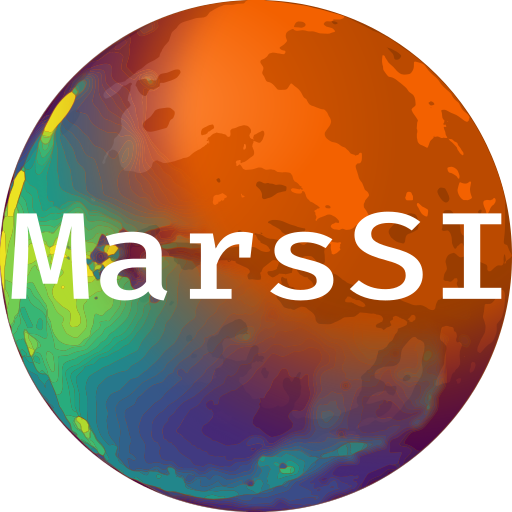Syntax highlighting of
THEMIS
{{/457px-Themis-lg.jpg}}
THEMIS (THermal Emission Imaging System) is a multispectral imager allowing the analysis of the morphology, the composition and the physical properties of the Martian surface. It has 9 channels in the thermal infrared between 6.78μm and 14.88μm and 5 channels in the visible and near-infrared between 0.42μm and 0.86μm.
<<TableOfContents()>>
== Data description ==
There are 3 types of THEMIS data: the infrared data, at 100 m/pixel, acquired by day and night, and the visible images, from 18 to 35 m/pixel (Christensen et al, 2004). The infrared images are approximately 30 km large and more than 100 km long on the surface and reached global coverage of the planet.
|| Data types || Spatial Res. || Number of Band || Spectral Range ||
|| (TIR) THEMIS Infrared Day || 100 m/pixel || 10 || 6.78–14.88 μm ||
|| (TIR) THEMIS Infrared Night || 100 m/pixel || 10 || 6.78–14.88 μm ||
The nighttime’s images of THEMIS allow constraining the thermal inertia of the surface. Those images have a higher resolution than the TES pixels (100 m/pixel versus 3 km/pixel). It allows a more local analysis than with the TES dataset. The global coverage of the THEMIS dataset allows also a regional study at high resolution. Global maps acquired by night and day are available.
Only Infrared THEMIS data are available for download on MarsSI. The calibration pipeline is not yet available in MarsSI but will eventually be implemented when confidence in the product quality is deemed sufficient. For viewing convenience, the footprints coverage has been splitted in 4 categories:
* THEMIS IR Day L: Long ground track during day time for infrared sensor
* THEMIS IR Day S: Short ground track during day time for infrared sensor
* THEMIS IR Night L: Long ground track during night time for infrared sensor
* THEMIS IR Night S: Short ground track during night time for infrared sensor
== Processing THEMIS data ==
From the “Maps” tab, zoom-in on your region of interest, you can display the THEMIS mosaic for more precision, and then display the THEMIS layer you are interested in. You get all stamps that appear. The stamps are regularly updated to take into account new data. You can use the “Select” button to choose the stamp you desire. You can choose several stamps by clicking several stamps, or by dragging your mouse to select adjacent stamps. You can also use the “Search” button for more options.
To add your desired stamps to your cart click on “Add” in the “Cart” window, and go to the “Workspace” tab. Your images appear in the window “Data to process”. If not, you may already have processed it yourself, or someone else may have processed it, then it may already be in the “Data processed” window.
== References ==
* THEMIS instrument description website: [[http://ode.rsl.wustl.edu/moon/pagehelp/quickstartguide/index.html|http://ode.rsl.wustl.edu/moon/pagehelp/quickstartguide/index.html?themis.htm]]
* THEMIS instrument description paper: CHRISTENSEN, Philip R., JAKOSKY, Bruce M., KIEFFER, Hugh H., et al.The thermal emission imaging system (THEMIS) for the Mars 2001 Odyssey Mission. Space Science Reviews, 2004, vol. 110, no 1-2, p. 85-130.
